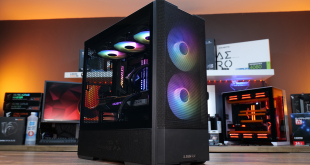As many of our regular readers will be aware, this weekend played host to the regional final of the Overclocking Masters competition where we teamed up with Asus, Kingston Technology and Multiplay to celebrate the dark art of overclocking. The nine finalists traveled from all over the country to attend the event at Asus secret underground bunker in North London.
The finalists were split up into five different teams and were handed identical X79 bundles of the latest and greatest components to overclock with. All of the bundles featured Asus’ behemoth Rampage IV Extreme motherboard paired with the top-end i7-3960X Extreme Edition CPU from Intel and a GTX 560 Ti graphics card from Asus.
Each system was powered using a 1000W Be Quiet! Dark Power Pro power supply and featured a Be Quiet! Dark Rock Pro CPU Cooler. All of the competitors were also supplied with the latest 120 GB HyperX SSDs and 8GB 1866 MHz RAM kits from Kingston.
All of the competitors were placed into random teams with a little help from Chenai, one of KitGuru’s models.
Team 1: Samuel Anderson-Burrell, an overclocking enthusiast who works in ICT support.
Team 2: Henry Johnston (right) and Alan Goodman (left). They have over 20 years overclocking experience between them. Henry is a refrigeration and air conditioning engineer and Alan works in IT and Telecoms.
Team 3: Bex Graham (centre) and Daniel Rogers (right). Bex works for Virgin Media and owns what we at KitGuru would call a proper enthusiast rig, featuring no fewer than four Crucial M4 SSDs in a RAID 0 array. She is also one of the only competitors who has experience overclocking with the X79 platform. Dan works for Codemasters and runs an X58 based system.
Team 4: Ed Parker (left) and Kenny Clapham (right). Interestingly the top two scorers in the first round of our competition ended up together, achieving 149% and 137.5% overclocks respectively. We look forward to seeing if they retain the performance crown in this round!
Team 5: Sam Denning (left) and Adrian Wheeldon (right). They are both students and have about 8 years overclocking experience between them.
The teams were then briefed by Paul Watkinson from Benchtec and were given an hour to build their systems ready for benching.
The complicated mounting mechanism of the Be Quiet Dark Rock Pro proved a little troublesome for some of the teams as they didn’t read through the instructions and installed it the wrong way round! It just goes to show that even hardcore overclockers can get things wrong sometimes! In the end, Bex came to the rescue in competitive spirit, helping the boys install their coolers correctly with her superior womanly expertise.
After a short break for a caffeine and sugar top-up, it was time for the competition to begin.
 KitGuru KitGuru.net – Tech News | Hardware News | Hardware Reviews | IOS | Mobile | Gaming | Graphics Cards
KitGuru KitGuru.net – Tech News | Hardware News | Hardware Reviews | IOS | Mobile | Gaming | Graphics Cards












Nice system build, shame the winners couldnt keep the system !
Will the next one be held somewhere else, out side the UK? seems unfair we can’t enjoy the event 🙁
Will the next one be held somewhere else, out side the UK? seems unfair we can’t enjoy the event 🙁
those boards are great, im still saving up for one of them. did anyone break the 5ghz barrier? I suppose with air cooling that would be hard.
Props to Bex for showing the guys how to build a PC :p
What’s a heatsink? 🙂
Yes, Dan and I (team 3) managed 5.1ghz stable and Adrin n’ Sam (team 5) I think managed about the same if not just a little higher.
So there’s a lesson for everyone … always read the instruction manual (though fiver says Bex didn’t bother with it anyway!)
If i remember rightly team 5 (Adrian and Sam) achieved a stable 5.15 GHz during the third test 🙂
Henry is right. We were around the 5.15Ghz mark which we we’re pretty happy with.
Thanks to everyone for the fun on the day. However I would like to point out that the heatsink issue was not our fault; they were not designed for the 2011 socket and in order to get them working you had to mount them at 90 degrees to almost every other heat sink design on the planet, meaning they would draw in hot air from the GPU or vent the hot CPU into the back of the GPU. I have included this in my email to Asus, along with other suggested inprovements.
I concur with Daniel. As I posted on the forums if you *DID* read the manual and followed it to a T you’d still have the mounting issue. Rotating the cooler meant the mounting brackets no longer wedged themselves on the CPU bracket but you still had to make sure you had used the washers which the guys forgot to use 😛
why not explain what bios configuration they used or if they used any mb hacks or anything to acquire such performance? what type of raid did they use? i mean, if you are just going to snap pictures and describe what can clearly be seen, don’t write your “article” then. it is a waste of everyone’s time. i came to here to learn something, guess that was too much of an expectation
Its not an ‘article’ on overclocking. It was an event held in England in which people we selected were sent to a secret location to enter an overclocking tournament. If you want to learn how to overclock there are many guides online. This was not a guide or article on how to overclock your system.